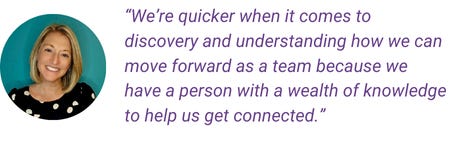Just make the pizza: How empathy builds great products
You can count clicks, but you have to feel frustration
Inspired by LaunchPod appearances:
From working a double shift in a pizza shop to picking and fulfilling orders in an auto parts store. It’s hard to understand your users if you haven’t done the job.
Customer research is vital, but often not enough. If you want to build real empathy as a product leader (and build products that really work), sometimes you need to step behind the counter and just “make the pizza” yourself.
Product managers talk a big game about empathy. But most have never lived their users' workflows.
Here’s how these leaders turn empathy into action:
Deepti Mendiratta, VP of Product at HungerRush
Susan Stavitzski, Principal Product Manager at CarMax
Julie Acosta, Dir. of eCom & Marketing Analytics at NOBULL (formerly Sr. Digital Analytics Manager at Autozone)
Live the workflow. Literally.
Support tickets and sales feedback aren’t the only way, or even the best way, to understand product pain points and opportunities for improvement.
At HungerRush, Deepti and her team actually stepped in to “make the pizza” with their users. Banging their elbows while running the drive-thru window, working double shifts, and dealing with last-minute order changes on the fly, they experienced the chaos of a quick-service restaurant firsthand.
But this allowed them to understand why certain processes had to be one-click, where user friction really was, and overall, how to improve their POS and ordering management technology in ways that drove benefit for their users.
“We’ve ingrained it in every single product person,” Deepti says. “Go live the life of your customer.”
Similarly, Julie Acosta and her team at AutoZone were required to work in physical AutoZone stores once a month, pulling parts and working at the counter, to directly experience the limitations of their digital catalog and in-store lookup system.
Action: Embed teams in frontline environments regularly, even for just a few hours. There is no better way to understand and empathize with how users interact with your product.
Translate emotion into design
You can count clicks. You have to feel frustration.
When Deepti was running the drive-thru, she tried to edit a customer’s order mid-dinner rush while three screaming kids waited in the back seat. "I panicked," she said. The system wasn’t built for quick edits, and the experience was overwhelming.
Feeling this firsthand helped Deepti deeply empathize with the users of their product, often teenagers working stressful, busy rushes:
“I didn’t just have the number of clicks as a metric. I also had the emotion that came with it.”
Julie’s AutoZone team saw the same thing. After working store shifts, they noticed language gaps in their catalog search that didn’t just annoy, they derailed entire transactions:
“When I went and worked in stores, I noticed that the way we, as product and tech people, had written catalog search didn’t line up with how a regular customer described their problem. Sometimes it would be enough friction that we’d lose the sale.”
Takeway: Numbers shouldn’t be the only thing that convinces you to prioritize a fix; lead with emotion and data, not just a ticket count.
Build for people who tap the keys
Your buyer isn’t always your user. Build for the people who tap the keys, not just the people who cut the checks.
“The actual user of the software could be anywhere from a 20-year-old kid to somebody who started the business on pen and paper,” Deepti says.
At HungerRush, talking to frontline workers helped her product team translate user pain points into what were essentially consulting-style advice for franchise owners and corporate customers. This strengthened the relationship across stakeholder levels.
Susan Stavitzski's team at CarMax took a similar approach. They hired former store employees (“Principal Field Leads”) into product teams to ensure deep frontline empathy and immediate reality checks:
“In order for us to truly know the field, there's nothing better than having someone who has worked in the field. So there is a principal field lead on the majority of product teams. We’re quicker when it comes to discovery and understanding how we can move forward as a team because we have a person with a wealth of knowledge to help us get connected.”
Action: Map every buyer and every user. Build direct feedback loops for frontline operators, not just executives.
Walk the walk: Bake hands-on empathy into your team’s culture
Empathy can’t be a one-time thing. It needs to be baked into your culture.
HungerRush doesn’t just make the pizza once; they’ve embedded it into their team culture through structured programs and expectations. Even new hires are expected to work in-store environments.
At AutoZone, HQ employees follow store dress codes, work holiday shifts in distribution centers, and regularly shadow stores. As one team member put it: “When you put yourself in the shoes of the store AutoZoner, you start thinking about things differently.”
Action: Make hands-on customer experience a standard part of OKRs, onboarding checklists, and performance reviews for PMs and designers. Walk the walk every month or quarter, and with every hire.
Takeaways
Support tickets don't paint the full picture. Empathy lives behind the counter, at the drive-thru window, in the back kitchen.
If you want to build better products, don’t just study your users – be the users. Make the pizza.







